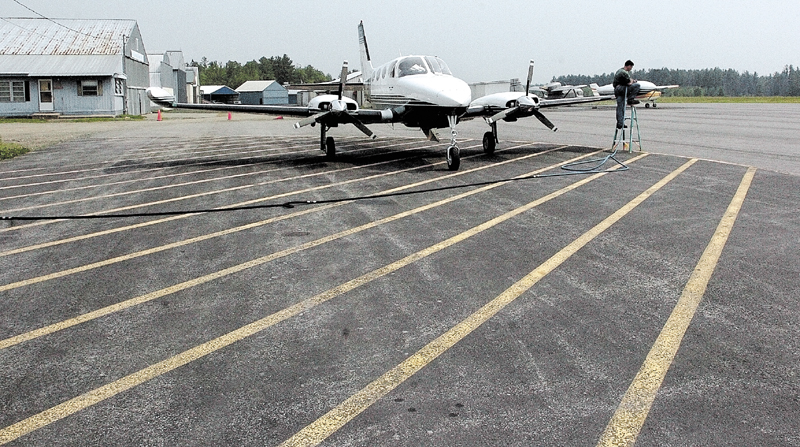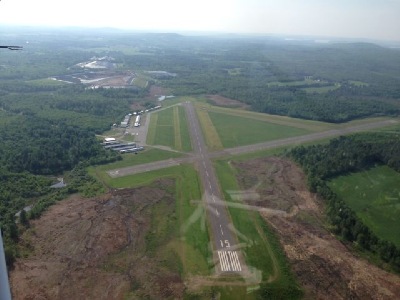NORRIDGEWOCK — State police and the Federal Aviation Administration are investigating reports of radio jamming near the airport that has made communication between pilots in the air impossible, according to police.
“When you have three planes that are trying to land at the same time and no one can talk to each other to say ‘Hey, I’m coming in on this runway’ or ‘I’m trying to land here,’ it’s very dangerous,” said Kris Wallace, operations manager of Central Maine Regional Airport in Norridgewock, on Tuesday.
She said someone with a handheld radio is tuning in to a frequency that serves an area from Auburn to Carrabassett Valley, then holds the channel’s communication line open, preventing pilots from communicating with each other. The radio jamming could lead to injuries, crashes or death.
Trooper Blake Conrad of the Maine State Police said jamming radio frequencies is a federal crime.
“The person responsible needs to know that jamming can be traced and this illegal activity needs to stop,” he said.
The problem began several weeks ago. Wallace said airport officials think the person responsible is purposely doing it to prevent pilots from communicating. She said the airport has received a few calls from pilots saying they almost had an accident because of the problem. It also has received reports that the radio channel is being used to turn runway lights on and off, an operation that can be controlled through a certain number of clicks on a radio button.
Dave Cota, town manager of Carrabassett Valley, said the Carrabassett Valley Regional Airport has been having similar problems, but he was unsure whether they were related.
Bill Gianetta, an aviation safety inspector for the Federal Aviation Administration in Portland, said the channel being disrupted is an advisory channel used by smaller airports in the state, including Auburn-Lewiston Municipal Airport and Pittsfield Municipal Airport, for pilots to communicate their position in the air and where they might be relative to the airport where they are landing.
The channel is not used by air traffic control for communication between controllers on the ground and pilots in the air, he said. It is not used by airports in Augusta, Bangor or Waterville or by the Portland jetport, he said.
It is used by LifeFlight of Maine, an emergency helicopter service, to broadcast an area weather forecast, a service to rural communities that LifeFlight also uses to ensure the safety of its own flights, said spokesperson Melissa Arndt. She said LifeFlight is investigating complaints related to the Norridgewock airport and the weather system.
Any radio operator can trigger a broadcast of the weather over LifeFlight’s Automated Weather Operations System through a few clicks of a radio button, Wallace said. She said that initially the jamming at the Norridgewock airport involved someone triggering the forecast multiple times in a row, preventing other messages from going through. The weather system was disconnected and now the person jamming the radio frequency is preventing others from using it by leaving the communication line open, she said. Only one person at a time may broadcast on a radio frequency.
Arndt said LifeFlight also is working with the Federal Communications Commission to investigate the channel’s operation. She said the disruption won’t affect operations of LifeFlight helicopters.
Wallace said anyone with a transceiver radio, the type used in most aircrafts, can interrupt a radio channel. The radios, which are also available in handheld versions, can be found online and purchased by anyone.
In 2012, the FCC investigated a report of what was believed to be intentional radio jamming of an emergency services channel in York County. The case never was solved, but it was believed to have impeded response times to several emergencies, including a Lebanon car crash in which 10 people were injured and one man died.
Gianetta said his administration has been notified about the problem at the Norridgewock airport and that it has forwarded the complaint to the FBI and Federal Communications Commission. Jamming of frequencies is traceable, but the FAA doesn’t have the equipment or knowledge to do so, he said. The FCC is responsible for investigating and prosecuting radio jamming cases, Gianetta said.
Mark Wigfield, spokesman for the FCC, said Tuesday that he could not confirm or deny whether the FCC was investigating jamming at the Norridgewock airport. He said the issue is one that the commission is trying to bring to a broader public attention.
The penalties for radio jamming can include significant fines of up to $16,000 for each violation or each day of a continuing violation, government seizure of equipment and imprisonment, he said.
Wallace said the airport is trying to notify as many pilots as possible about the radio problem, including via the airport’s Facebook page.
“We want them to know this is happening, to be careful and that it is under investigation right now,” she said.
Rachel Ohm — 612-2368
rohm@mainetoday.com
Send questions/comments to the editors.





Comments are no longer available on this story